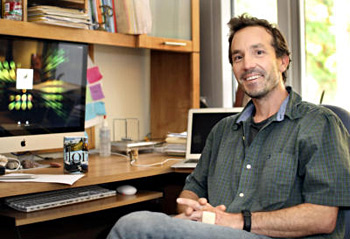One subtype of breast cancer shares many genetic features with high-grade serous ovarian cancer, a cancer that is very difficult to treat, according to researchers supported by the National Institutes of Health. The findings suggest that the two cancers are of similar molecular origin, which may facilitate the comparison of therapeutic data for subtypes of breast and ovarian cancers.
The study, using data generated as part of The Cancer Genome Atlas (TCGA), was published September 23 in Nature. Researchers described new insights into the four standard molecular subtypes of breast cancer based on a comprehensive characterization of samples from 825 patients.
TCGA collaborators at the University of California, Santa Cruz, and the Buck Institute made significant contributions to the research, identifying molecular pathways that are affected by the genomic changes found in the patients' tumors. "Pathway analysis is one of our strengths," said Joshua Stuart, associate professor of biomolecular engineering in UCSC's Baskin School of Engineering. "The analysis points to common molecular circuitry between cancers arising in different tissues. Such connections may inform us about new directions for therapy."
A key tool for pathway analysis is a software program called PARADIGM, developed at UCSC by a team led by Stuart and David Haussler, distinguished professor of biomolecular engineering and director of the Center for Biomolecular Science and Engineering. PARADIGM enables researchers to assess the consequences of a mutation and identify different genetic changes that affect a common molecular pathway. "We've been able to read mutations but we haven't been able to understand them," Haussler said. "PARADIGM allows us to look at multiple sources of data from patient samples and figure out which genetic pathways are altered from their normal function."
TCGA, which involves more than 150 researchers working at dozens of institutions across the country, is in the midst of a five-year effort aimed at generating comprehensive, multi-dimensional maps of the key genomic changes in major types and subtypes of at least 20 different cancer types. The research--which has already reported on glioblastoma multiforme (a type of brain cancer), serous ovarian cancer, colorectal cancer, and lung squamous cell cancer--is expected to result in a flood of discoveries that could lead to more powerful and personalized treatments based on targeting the genetic vulnerabilities of tumors.
UC Santa Cruz and the Buck Institute for Research on Aging have partnered to create one of seven TCGA Genome Data Analysis Centers (GDACs), which provide the highest level of integrated analysis of the comprehensive datasets derived from in-depth assays of the DNA, RNA, and protein from nearly 500 cases of each cancer type.
"In this transformative breast cancer paper, TCGA identified at least 40 possible drug targets, many of which would not have been considered breast cancer targets, but are instead borrowed from other areas of oncology," said Buck professor Christopher Benz, MD, a co-principal investigator of the UCSC-Buck Institute GDAC. Benz, who is also a practicing oncologist at UCSF's Carol Franc Buck Breast Care Center, said the unprecedented analysis, which involves the integration of information across six different technology platforms, allows researchers to go beyond genetic mutations associated with breast cancer.
"We're now able to delve into the downstream molecular pathways that may or may not be activated in a particular tumor," he said. "This is what is going to get us into personalized, precision medicine where we can tailor treatments to very specific breast cancer subtypes. There is a lot of work still to be done, we need to validate these novel pathways, but this study is a major step that will propel therapeutic advances in this direction."
Working with graduate student Christopher Szeto at UCSC, Buck Institute staff scientist Christina Yau was instrumental in identifying molecular pathways that are commonly activated in basal-like breast tumors and serous ovarian cancers, both of which are known to be particularly aggressive. "There is currently no targeted therapy for basal-like breast cancer, which is more common in African American and younger women," said Yau, who pointed out that TCGA authors suggest that therapies now used to treat ovarian cancer should be considered for patients diagnosed with basal-like breast cancer. "This discovery definitely offers new treatment opportunities for breast cancer patients," she said.
Computational analyses show that basal-like breast cancer and serous ovarian cancer might both be susceptible to agents that inhibit blood vessel growth, cutting off the blood supply to the tumor, as well as to compounds that target DNA repair, which include chemotherapy drugs such as cisplatin.
The basal-like subgroup has also been called triple-negative breast cancer because many, though not all, basal-like tumors are negative when tested for three receptors: the estrogen receptor, the progesterone receptor, and human epidermal growth factor receptor 2 (HER2). These receptors can trigger potent cell growth responses and act like a nametag, identifying the cell to the environment. The absence of these receptors means that treatments that target them will most likely be ineffective.
"The molecular similarity of one of the principal subtypes of breast cancer to that found in ovarian cancer gives us additional leverage to compare treatments and outcomes across these two cancers," noted Harold Varmus, M.D., director of the National Cancer Institute. "This treasure trove of genetic information will need to be examined in great detail to identify how we can use it functionally and clinically."
More than 200 scientists are named as contributors to this research. Other collaborators from UCSC include Stephen C. Benz, Jinchun Zhu, Evan O. Paull, Daniel Carlin, Christopher Wong, Artem Sokolov, Sam Ng, Theodore C. Goldstein, Kyle Ellrott, Mia Gifford, Christopher Wilks, Singer Ma and Brian Craft. Other Buck Institute researchers involved in the study include Gary K. Scott, Janita Thusberg and Sean Mooney.
TCGA is a collaborative effort funded by the National Cancer Institute (NCI) and the National Human Genome Research Institute (NHGRI), both part of NIH. UCSC researchers led by Haussler have established the Cancer Genomics Hub (CGHub), a large-scale data repository and user portal for TCGA and the National Cancer Institute's other cancer genome research programs.



